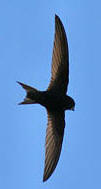|
Classification "Where do I fit in?"
|
|
Domain: Eukarya Kingdom: Animalia Phylum: Chordata Class: Aves Order: Apodiformes Family: Trochilidae Genus: Archilochus Species: Archilochus colubris
|
|
What do These Classifications Mean? Eukarya - membrane-bound organelles, genetic material contained in nucleus, complex cells Animalia - multicellular, heterotrophic, lack a cell wall, possess tissues Chordata - bilateral symmetry, true body cavity, notochord, dorsal tubular nerve cord, postnatal tail, pharyngeal pouches, endostyle Aves - wings, feathers, air cavities in skeleton, beak with no teeth, amniotic eggs, endothermic Apodiformes - "unfooted birds," tiny feet, long wings Trochilidae - long wings with a short, thick humerous, enlarged flight muscles, small feet with sharp, curved claws Archilochus - includes all hummingbirds, narrow elongated beak, extendable tongues, hovering flight
|
|
Phylogenetic Tree "An Oversized Family Tree"
|
|
The phylogenetic tree above shows the classification of the Ruby-Throated Hummingbird. It begins with the hummingbird's broadest classification, the domain, Eukarya, and narrows all the way down to the species, Archilochus colubris. As you can see, the order Apodiformes branches off into three groups, meaning these three families, Apodidae (Swifts), Trochilidae (Hummingbirds) and Hemiprocnidae (Tree Swifts) are monophyletic, or have a common ancestor. Characteristics that support this relationship are: small to very small birds, a similar wing structure, and small feet that are useless for walking. The main differentiations between the members of this group can be found in the methods of their flight and in their musculature. Swifts glide rather than flap their wings, so their muscles make up a small portion of their body mass. Hummingbirds hover with rapid wing beats, so they possess very powerful flight muscles.
For more information on the Ruby-throated Hummingbird's phylogenetic history and to explore how other animals are related, check out:
|
![]()
![]()
![]()
![]()
![]()
![]()
![]()
![]()
![]()
![]()
![]()
![]()
![Text Box:
Eukarya Animalia Chordata Aves
Apodidae [swifts]
Apodiformes Trochilidae Archilochus Archilochus colubris
Hemiprocnidae [tree swifts]](classification_files/image013.gif)







